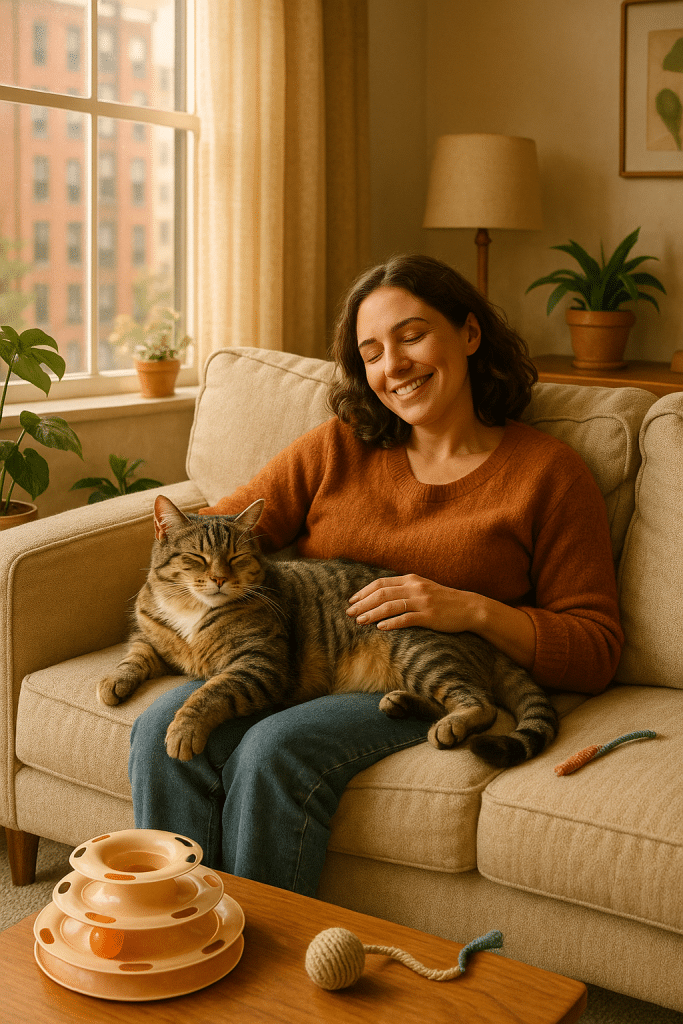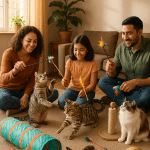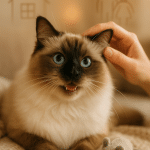Living in an apartment can be a wonderful experience, but it also presents unique challenges when it comes to choosing the right pet. Cats, often celebrated for their independence and adaptability, can be fantastic companions for apartment dwellers—provided you pick the best cats for apartments. I’ve spent years working with pet owners and families, helping them understand which cat breeds thrive in smaller spaces and how to care for them properly.
In this comprehensive guide, I’ll walk you through everything you need to know—from understanding what apartment life means for your feline friend to selecting a breed that fits your lifestyle. We’ll explore key traits such as calm temperament, low energy, and grooming needs that make certain cats ideal for confined living. You’ll also find practical tips on training, enrichment, and managing common challenges apartment cat owners face. Whether you’re a first-time renter or a seasoned pet owner, this article will equip you with expert insights and actionable advice for creating a harmonious home with your new feline companion.
Let’s dive right in and discover the best cats for apartments that offer affection, serenity, and minimal fuss.
Understanding Apartment Living Requirements for Cats
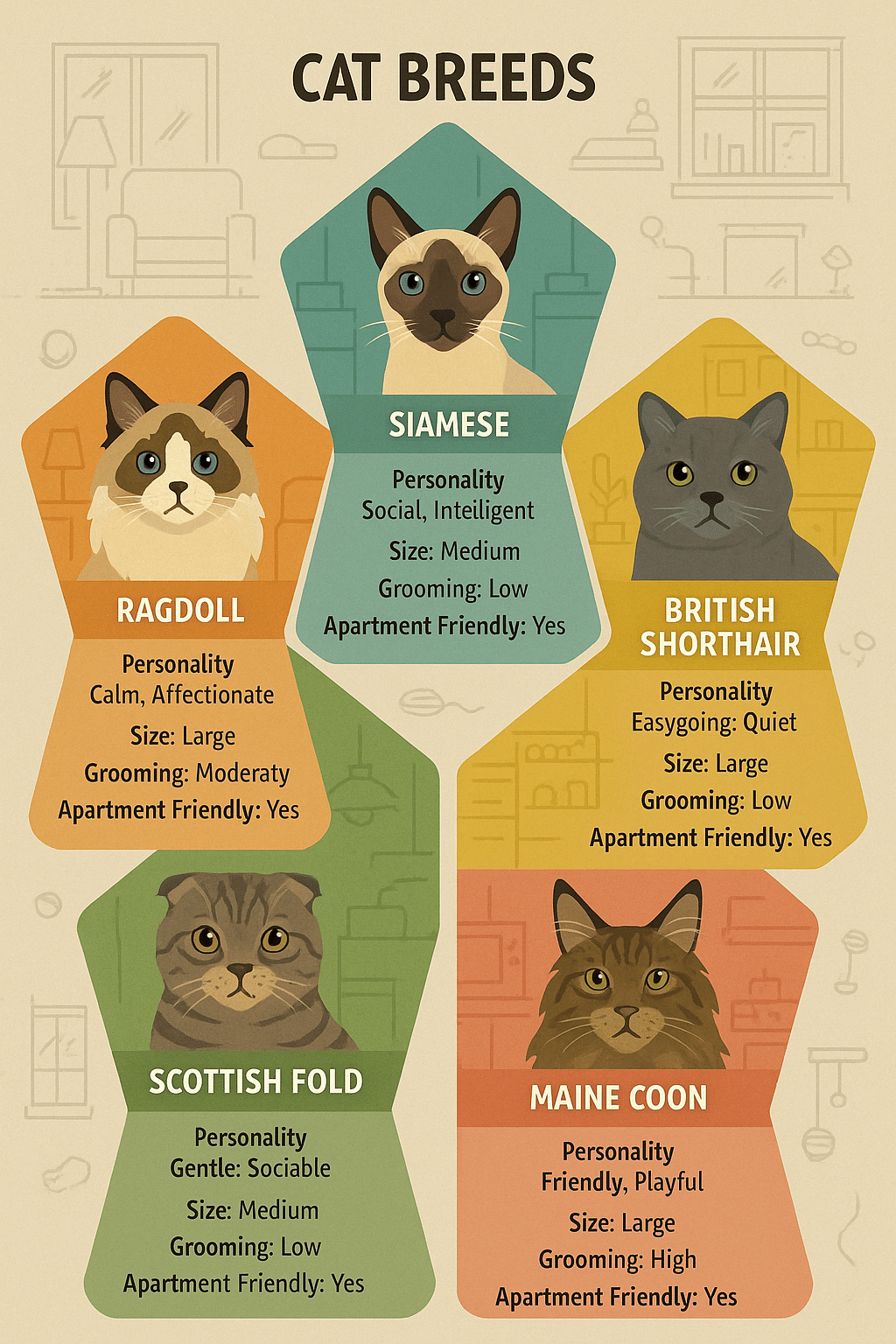
Challenges of Small Space Living for Cats
Apartment living comes with a distinct set of constraints for cats. Unlike a house with sprawling yards, apartments often mean limited square footage, fewer vertical spaces, and restricted window views, all of which can impact a cat’s physical and psychological well-being. Confined areas can lead to boredom, stress, and even behavioral problems if not addressed properly. It’s crucial to acknowledge that cats, while adaptable, need stimulation, territory, and privacy to thrive.
Furthermore, noise and proximity to neighbors can sometimes cause anxiety in sensitive cats. For instance, loud footsteps from upstairs or barking dogs in neighboring units can unsettle a cat unused to such disturbances. Additionally, the absence of safe outdoor access makes indoor enrichment a top priority. This means your choice of cat breed must align well with these spatial and sensory considerations.
Importance of Choosing the Right Cat Breed
Selecting the right breed is more than just picking a cute kitty; it’s about matching temperament, activity level, and care needs to your living situation. Some cats are naturally high-energy and require ample space to run and climb. Others prefer a laid-back routine and small, cozy spots to lounge in. Recognizing the breed traits—such as energy levels, sociability, and grooming requirements—will minimize frustration on both ends and set you up for a successful cohabitation.
Breed selection also impacts your lifestyle. If you have a busy schedule, a low-maintenance and independent breed might be preferable. For families with kids, a playful and tolerant breed might be a better fit. Whatever your case, understanding your apartment and personality match is the foundation of a happy cat-owner relationship.
Creating a Cat-Friendly Apartment Environment
Even with the best breed, an uncluttered and stimulating environment is essential. For cats living in apartments, vertical space is golden. Cat trees, shelves, and window perches not only satisfy their instinct to climb and observe but also expand their usable territory without taking up floor space. Integrating puzzle feeders and interactive toys can help prevent boredom, while cozy hideouts provide safe retreats to relax.
It’s also important to maintain a calm, predictable space since cats thrive on routine. A consistent placement of food bowls, litter boxes, and toys will help your feline friend feel secure in the limited space. With thoughtful design and appropriate breed selection, apartment living can be as enriching as any larger home.
Key Traits to Look for in the Best Cats for Apartments
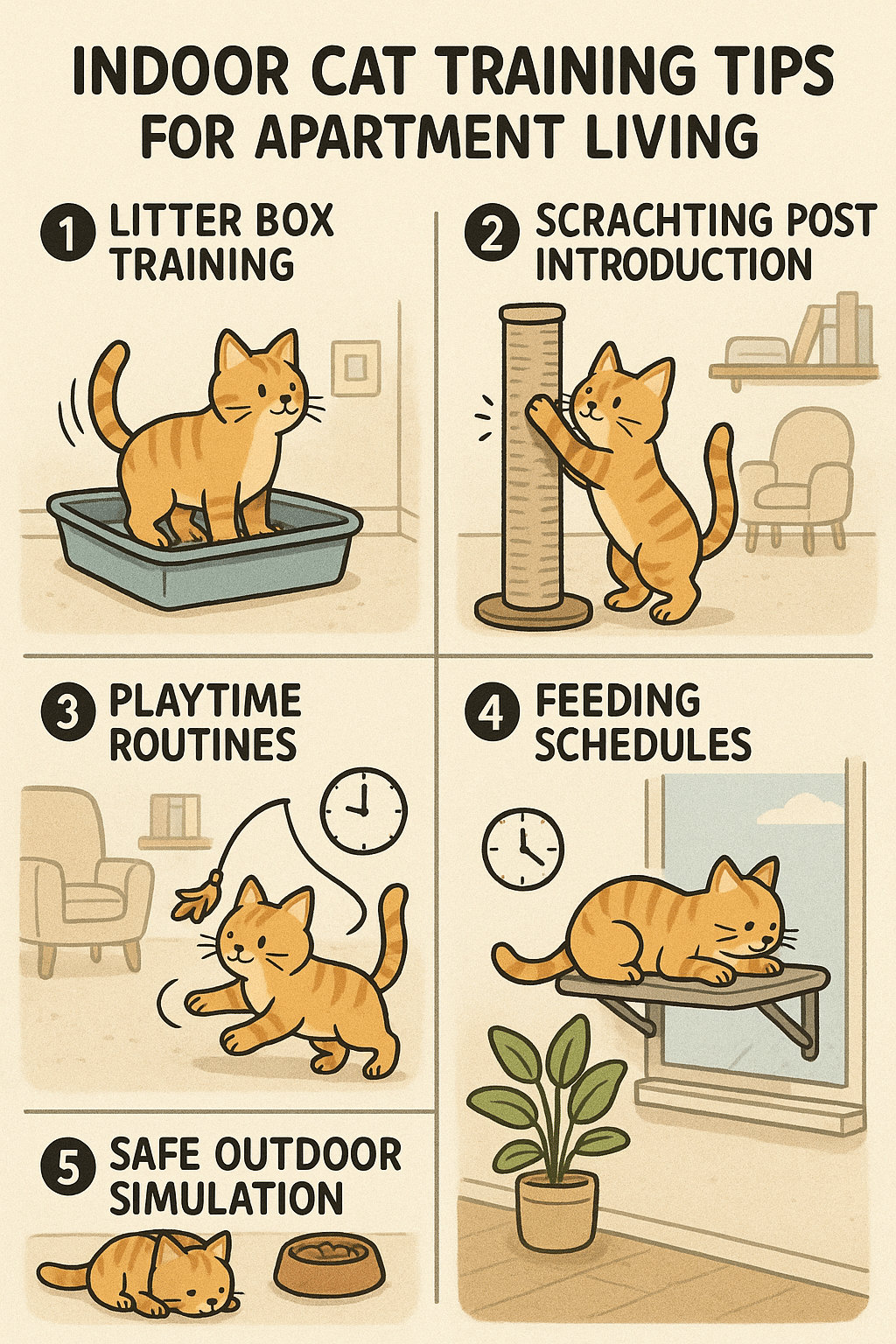
Calm Temperament and Low Energy Levels
When space is tight, it’s beneficial to choose cats with inherently calm dispositions and moderate to low energy levels. Cats like this tend to be more content with limited room to roam and are less likely to seek risky escapes or develop destructive behaviors out of boredom.
For example, cats such as the British Shorthair and Scottish Fold exhibit laid-back personalities and are often content napping on cozy spots. They don’t demand excessive playtime or outdoor exploration, making them perfect for studio or one-bedroom apartments.
Adaptability and Social Behavior
Adaptability is a cornerstone trait for apartment-friendly cats. This means a cat’s ability to adjust to new environments, noises, schedules, and close human contact without stress. Social cats that enjoy interaction with family members and visitors tend to fare well in apartments, where exposure to people is frequent but space is confined.
Ragdolls and Burmese cats, for instance, are known for their social and affectionate nature, enjoying human company without being overly demanding. This balance of loving attention and easygoing attitude makes daily life smoother.
Grooming Needs and Maintenance
Apartment living often means less tolerance for pet hair and dander accumulation. Choosing a breed with manageable grooming needs can save time and effort, keeping your living area clean and odor-free. Short-haired breeds generally shed less and require minimal grooming routines, whereas long-haired cats like Ragdolls, while affectionate, do need regular brushing to prevent mats and hairballs.
Availability of hypoallergenic qualities is also important for multi-person households or guests with mild allergies, which we will discuss more shortly.
Affection Levels Suitable for Apartment Families
Cats vary widely in how much they seek affection and interaction. In apartments, where space limitations increase time spent together, choosing a breed with matching affection needs ensures harmony. Cats that thrive on petting, lap time, or gentle play foster strong emotional bonds with families, enriching their apartment experience.
This trait is particularly vital for households with children or busy individuals seeking a cuddle buddy. Cats like Burmese and Ragdolls, known for their “dog-like” affection, are excellent choices in these scenarios.
Hypoallergenic Qualities and Shedding Considerations
While no cat is truly hypoallergenic, some breeds produce fewer allergens and shed less, which greatly benefits apartment dwellers, especially those prone to allergies. Low-shedding breeds reduce airborne dander, making the environment more comfortable for everyone.
Russian Blues, British Shorthairs, and Scottish Folds tend to shed moderately less compared to other breeds, though regular grooming will always help keep allergens at bay. Advanced cleaning tools like HEPA air purifiers and lint rollers also support allergen control in small living spaces.
Top 5 Cat Breeds Ideal for Apartment Living
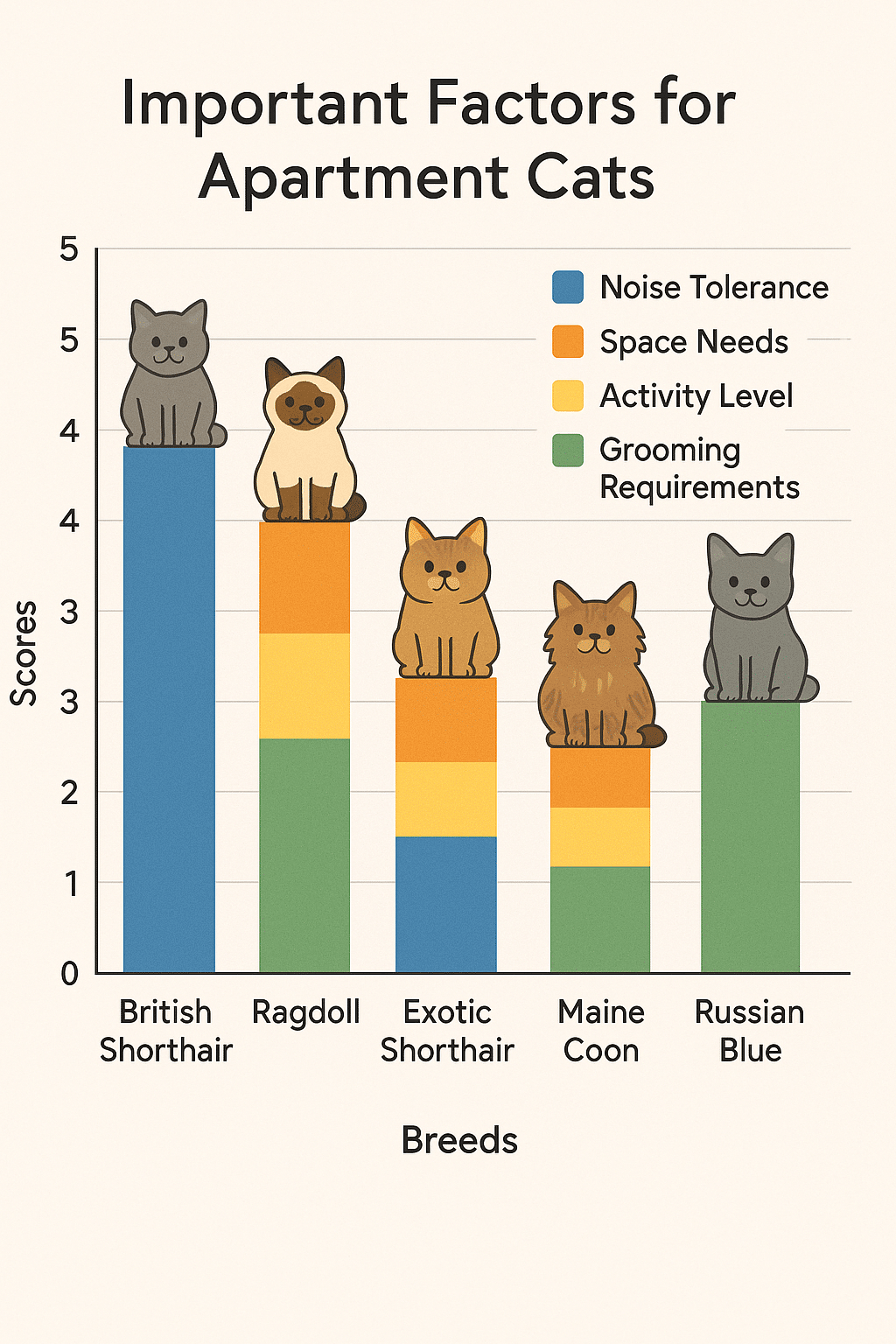
British Shorthair: Quiet, Independent, and Low Maintenance
Personality and Adaptability
The British Shorthair stands out as a top contender for apartment cats due to its calm, easygoing nature. These cats are famously placid, and their mellow temperament lets them adapt well to smaller, quieter environments. They enjoy lounging around but remain alert and curious enough to engage in light play, fitting perfectly into the life of a busy professional or a family with kids.
They are renowned for being good-natured without being overly clingy, making them ideal for homes where owners may be out during the day.
Grooming and Care Requirements
British Shorthairs have dense, plush coats that do shed, but not excessively. Weekly brushing helps manage shedding and keeps their fur plush and soft. Their coat is relatively resilient, requiring no special grooming products beyond a good quality brush.
They typically enjoy a diet tailored to prevent weight gain since their low activity level may lead to some obesity if overfed, a critical point to remember in limited space.
Best for Families and Busy Owners
This breed’s quiet independence is a boon for apartment owners who want a companion without constant demands. British Shorthairs often tolerate solo time well, making them suited for first-time renters or those balancing work and life.
Ragdoll: Affectionate, Laid-Back, and Social
Temperament and Interaction Needs
Ragdolls are among the most affectionate cat breeds, often described as “puppy-like” due to their tendency to follow owners around and enjoy cuddling. Their calm and gentle demeanor makes them ideal for apartment families who seek constant interaction and warmth from their pets.
They tolerate other pets and children well and are known for their relaxed posture when held, making them a joy for lap lovers.
Grooming Tips for Apartment Owners
Despite their long, silky coat, Ragdolls are surprisingly low-maintenance. They require brushing at least twice weekly to avoid tangles and mats. Investing in a good slicker brush and a stainless-steel comb ensures efficient grooming sessions.
Regular grooming also keeps hairballs at bay, which is particularly important when living in close quarters.
Russian Blue: Elegant, Reserved, and Low Shedding
Behavior in Confined Spaces
The Russian Blue is a reserved and gentle breed, known for its quiet demeanor and intelligence. These cats adapt exceptionally well to smaller spaces thanks to their balanced energy—neither too frantic nor entirely sedentary. Their reserved nature means they rarely create noise disturbances, perfect for apartment neighbors’ peace of mind.
They tend to bond closely with their owners but are selective about strangers, striking a good balance between affection and independence.
Allergy-Friendly Attributes
Russian Blues produce fewer allergy-inducing proteins than many other breeds, making them a popular choice among allergy-sensitive pet owners. Coupled with their low shedding coat, they help maintain better air quality inside smaller apartments.
Scottish Fold: Sweet Temperament and Adaptability
Playfulness Versus Calmness Balance
Scottish Folds are recognized for their unique folded ears and sweet disposition. These cats strike a fine balance between playfulness and calmness, which can keep children entertained yet remain composed enough for a quiet apartment environment.
They enjoy interactive play but also appreciate relaxing with their owners on the couch or in cozy nooks.
Managing Unique Physical Traits in Apartments
Owners must be mindful of the Scottish Fold’s cartilage condition, responsible for their ears. Providing safe spaces where they can move without risk of injury is crucial. Regular veterinary care paired with apartment safety measures ensures their comfort and health.
Burmese: Playful, Loving, and Family-Friendly
Energy Management in Smaller Spaces
Burmese cats bring a vibrant, playful spirit that many families adore. While they have higher energy levels than some breeds, their playful nature can be channeled indoors with the right toys and activities. For apartment owners, this means dedicating time daily for interactive sessions to burn off energy healthily.
Social Needs and Training Tips
Burmese are highly social and crave attention, so they excel in families that can provide ample affection and interaction. Training Burmese cats to follow commands and engage in positive play helps manage their high energy and fosters good behavior in constrained spaces.
How to Train and Enrich Cats in Apartments for Optimal Wellbeing
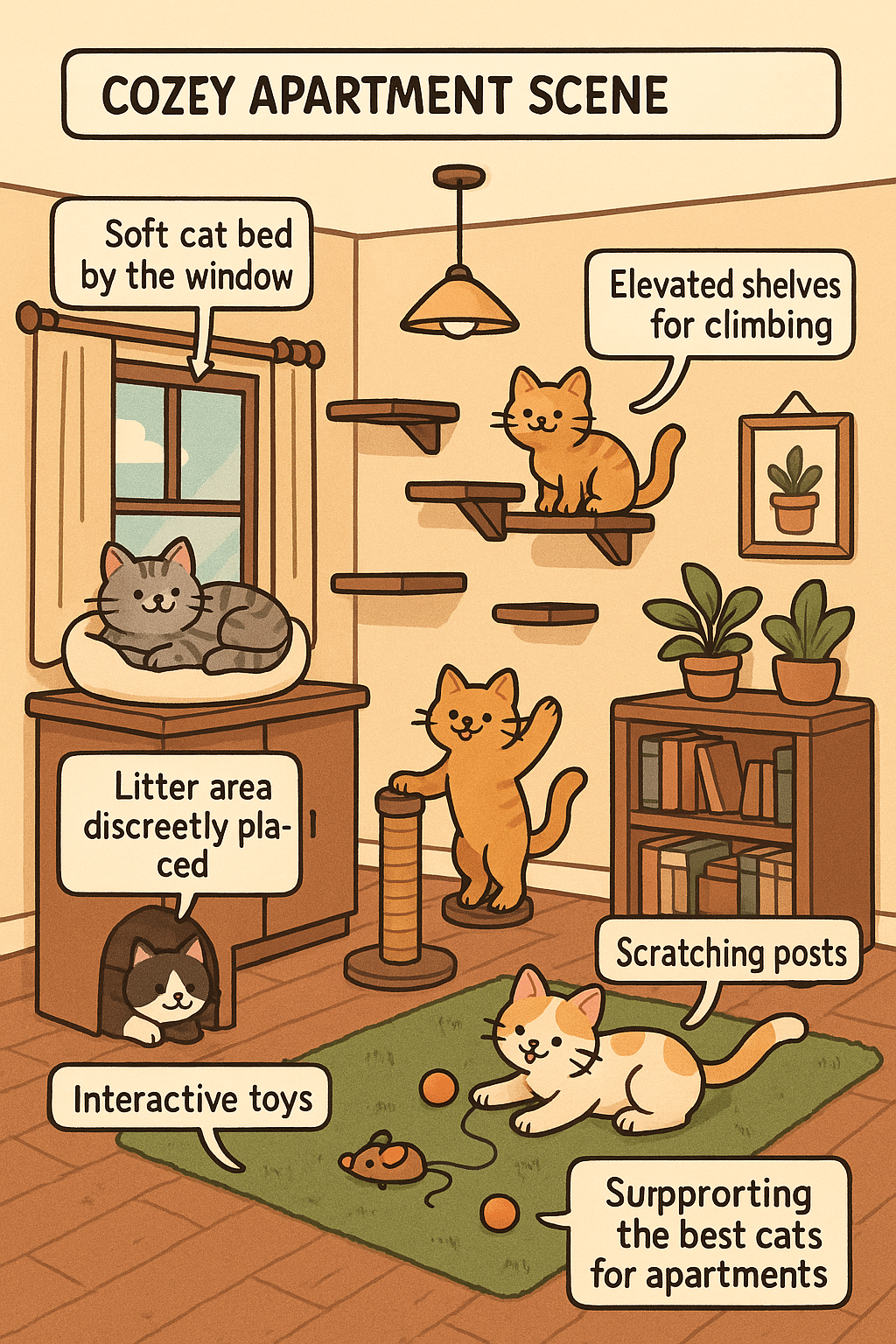
Providing Vertical Space and Interactive Toys
Because floor space in apartments may be limited, creating vertical territory is key for your cat’s happiness. Installing cat trees, wall-mounted shelves, and window perches lets cats climb and survey their environment, stimulating their natural instincts.
Interactive toys such as laser pointers, feather wands, and puzzle feeders engage a cat’s brain and body simultaneously, helping to prevent boredom and destructive behaviors commonly seen in confined animals.
Effective Litter Box and Scratching Post Setup
Maintaining an odor-free, clean environment is a must in apartments. Position litter boxes in quiet, low-traffic areas and scoop daily. Opt for covered boxes if odor or litter scatter is a concern.
Scratching posts, ideally several around the apartment, give cats outlets for natural scratching behavior and prevent unwanted damage to furniture.
Managing Playtime for Active and Calm Cats
Active cats require scheduled playtime to satisfy their exercise needs. Short bursts of energy spent with toys twice or thrice a day prevent restlessness. Meanwhile, calm cats benefit from gentle, consistent interaction that nurtures bonding without overwhelming their space.
Behavior Training Tailored to Apartment Living
Use positive reinforcement such as treats and verbal praise to train cats from the outset. Setting boundaries gently but firmly discourages behaviors like jumping on counters or excessive vocalization that might disturb neighbors.
Routine helps cats feel secure. Feeding, playing, and cleaning schedules stabilize their behavior and promote wellbeing in confined environments.
Addressing Common Challenges Apartment Cat Owners Face
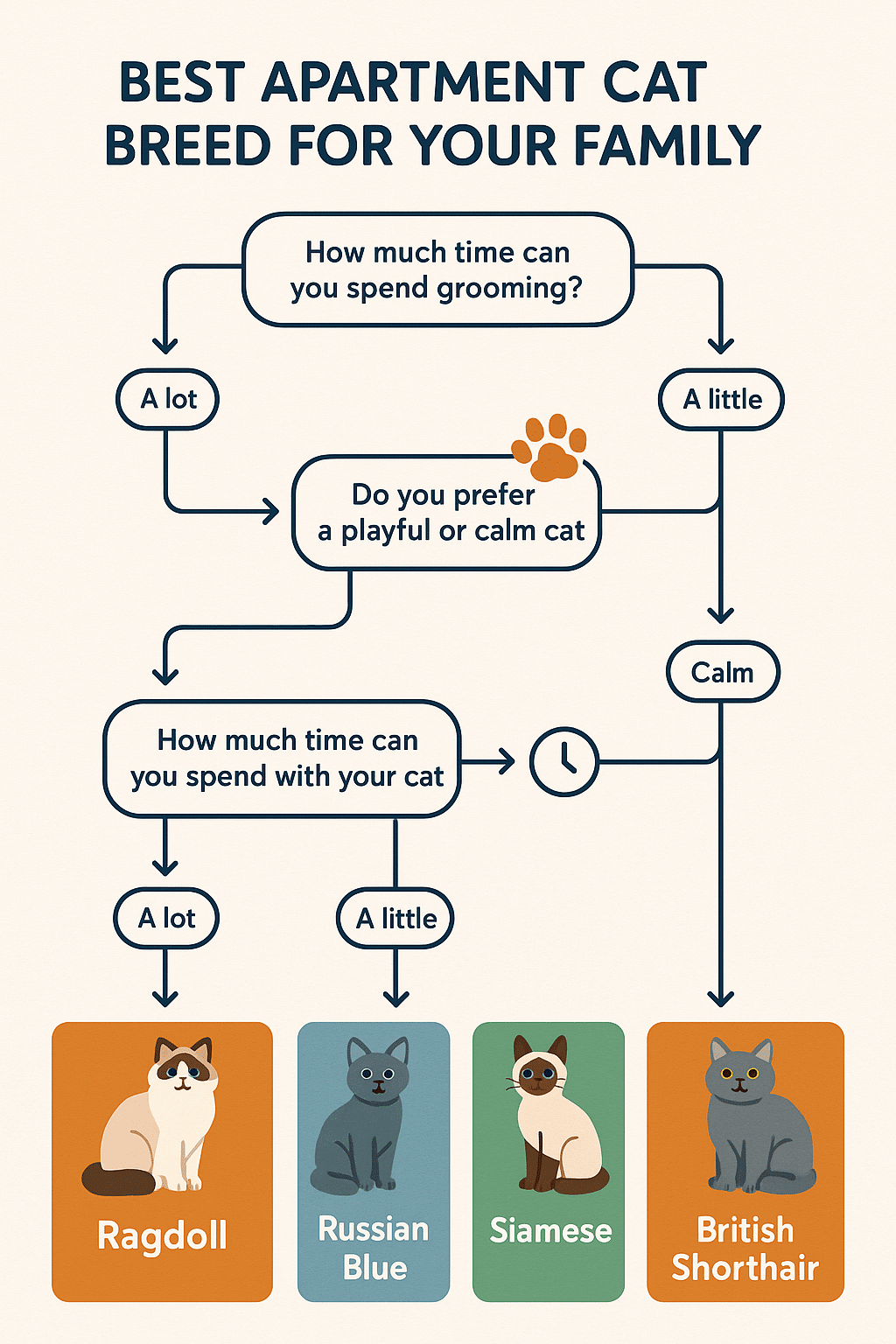
Noise Sensitivity and Neighbors
Noise from neighbors or street traffic can stress some cats. Using white noise machines, window insulation, or calming pheromone diffusers (e.g., Feliway) can ease anxiety. Early socialization helps cats acclimate to ambient sounds and reduce overreaction.
Managing Mixed Pet Households
Apartment owners with multiple pets face unique challenges in space sharing and inter-pet dynamics. Careful introductions, separate resources (food bowls, litter boxes), and supervised interactions ensure harmony and prevent territorial disputes.
Dealing with Limited Outdoor Access
Without safe outdoor access, indoor cats need plenty of enrichment. Creating stimulating environments with varied textures, perches, and toys reduces the risk of obesity and mental stagnation. Consider rotating toys regularly and, if possible, supervised outdoor access via secure balconies or patios.
Essential Apartment Cat Supplies and Environmental Enhancements
Selecting Cat Furniture and Hideouts
Invest in multi-functional cat trees that combine climbing, scratching, and sleeping areas. Cozy hideouts such as covered beds, tunnels, or boxes allow cats to retreat and feel safe in a small apartment.
Maintaining Air Quality and Minimizing Allergens
High-quality air purifiers reduce dander and dust accumulation. Regular vacuuming with a HEPA filter vacuum and frequent cleaning of cat areas help maintain hygiene.
Grooming Tools and Pet Care Products for Indoor Cats
Stock up on shedding brushes, nail trimmers, ear cleaners, and dental care kits to maintain your cat’s health. Regular grooming sessions also double as bonding time and help you catch early signs of health concerns.
Unique Insights: The Role of Cat Personality Matching in Apartment Selection
Balancing Owner Lifestyle with Cat Energy Levels
Matching your personal lifestyle with a cat’s energy and social needs is the secret to a lasting relationship. For example, busy professionals may lean towards independent breeds like British Shorthairs, while families with kids might enjoy the playful Burmese or affectionate Ragdoll.
Using Personality Assessments to Avoid Behavioral Issues
Many shelters and breeders offer personality evaluations. Utilizing these tools helps predict a cat’s adaptability to confined apartment life and compatibility with human routines, reducing adoption return rates.
Long-Term Health and Happiness in Confined Spaces
Providing mental and physical stimulation, regular vet care, and social interaction ensures that apartment cats enjoy long, happy lives despite limited outdoor experiences.
Final Recommendations: Choosing the Best Apartment Cat for Your Family
Matching Cat Breed Traits to Family Dynamics
Consider the energy, social needs, grooming, and temperament of breeds against your household’s profile. A calm, independent British Shorthair may suit quieter homes, whereas a chatty, sociable Burmese fits active families.
Planning for Longevity and Ongoing Care
Cats can live well into their teens, so think long term about diet, exercise, veterinary care, and mental enrichment. Be prepared for commitment and evolving needs over time.
Preparing Your Apartment Before Bringing Your Cat Home
Cat-proof your space by securing windows, hiding cords, and removing toxic plants. Set up designated feeding, litter, and play areas beforehand to provide a seamless welcome.
FAQs about Best Cats for Apartments
Q1: What are the best cat breeds for apartment living with children?
Breeds like the Ragdoll, Burmese, and Scottish Fold are excellent with kids due to their gentle and social natures. They balance playfulness with patience, making them apartment-friendly family pets.
Q2: Are hypoallergenic cats suitable for small apartments?
Yes, breeds like Russian Blues and British Shorthairs produce fewer allergens and shed less, helping maintain a cleaner apartment environment while being easier on allergy sufferers.
Q3: How can I keep my apartment cat entertained without outdoor access?
Use vertical spaces, interactive toys, puzzle feeders, and regular play sessions to keep your cat stimulated. Rotating toys and providing window views enhance enrichment.
Q4: Is it okay to keep multiple cats in an apartment?
It can be, provided there’s enough space, resources, and careful introductions. Multiple litter boxes, feeding stations, and separate rest areas help reduce stress and territorial behavior.
Q5: How often should I groom my apartment cat?
Grooming frequency depends on breed. Short-haired cats like British Shorthairs need weekly brushing, while long-haired breeds like Ragdolls require brushing two to three times per week to prevent mats and reduce shedding.
Quick Takeaways
- Calm, low-energy breeds like British Shorthairs fit well in apartments.
- Affectionate, social breeds such as Ragdolls thrive with interactive families.
- Vertical space and environmental enrichment are essential for indoor cats.
- Grooming needs should align with owner capacity and apartment cleanliness goals.
- Hypoallergenic breeds minimize dander for allergy-sensitive households.
- Behavior training and routine help prevent common apartment pet issues.
- Preparation and personality matching ensure long-term cat-owner harmony.
Conclusion
Choosing the best cats for apartments is as much about understanding your home and lifestyle as it is about picking a breed. From the calm and independent British Shorthair to the affectionate and playful Burmese, there’s a cat perfectly tailored for your living space. Remember, apartment cat ownership isn’t just about breed—it requires commitment to creating an enriched, safe environment and fostering routines that satisfy your cat’s physical and emotional needs.
I encourage you to reflect on your family dynamics, daily schedule, and the environmental features of your apartment before bringing a new feline friend into your life. With the right preparation and breed selection, your apartment can become a haven for your cat’s happiness and health.
Ready to find your perfect apartment cat? Start by visiting reputable breeders or local shelters, and don’t hesitate to seek personality assessments. The purr-fect companion awaits—one who will fill your apartment with love, joy, and serene companionship.
For further reading and resources on cat breeds and apartment living tips, check out:
- The International Cat Association (TICA)
- Cat Fanciers’ Association (CFA)
- American Society for the Prevention of Cruelty to Animals (ASPCA)
- Feliway Pheromone Products

